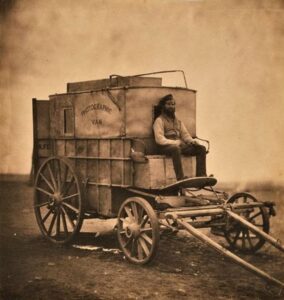 After graduating from a London University with an Arts degree, Roger Fenton (1819-1869) became interested in painting and later developed a keen interest in a new technology called photography. He became the most celebrated and influential photographer in England during the medium’s “golden age” of the 1850s. Instrumental in founding the Royal Photographic Society, he was known as one of the first war photographers.
After graduating from a London University with an Arts degree, Roger Fenton (1819-1869) became interested in painting and later developed a keen interest in a new technology called photography. He became the most celebrated and influential photographer in England during the medium’s “golden age” of the 1850s. Instrumental in founding the Royal Photographic Society, he was known as one of the first war photographers.
His acclaim came in 1855, with photographs of the Crimean War, a conflict in which British, French, Sardinian, and Turkish troops battled Russia’s attempt to expand its influence into European territory of the Ottoman empire. Major engagements were fought at the Alma River in Russian Crimea including the battle at Balaklava on October 25, which was commemorated by English poet Alfred, Lord Tennyson in “The Charge of the Light Brigade”, into the valley of death rode the six hundred . . .
In 1862 the International Exhibition in London announced its plans to place photography, not with the other fine arts, but in the section reserved for machinery, tools and instruments. Photography was considered a craft, for tradesmen and not a serious artistic endeavor. For Fenton, this was conclusive proof of photography’s diminished status, including his own, as one of the medium’s pioneers. He retired from photography, his first love, and returned to practicing law.
Almost in obscurity, he died 7 years later at the age of 50, with his wife Grace Elizabeth Maynard passing 17 years later. Fittingly, Roger Fenton became recognized by historians for his groundbreaking work in photography and artistic accomplishments.
Oh yeah. The picture above, taken in 1855, is of Fenton’s Photographic Van used as a portable dark room at various battle field locations. The rider is Fenton’s capable wartime photography assistant, Marcus Sparling.
